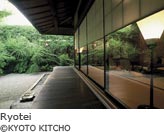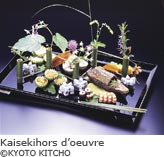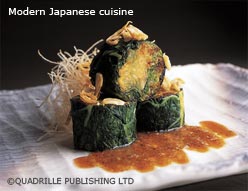Contemporary cuisine |
||
 |
Japanese cuisine is based on the enjoyment of a richly varied table offering a nutritional balance
through a range of seasonal offerings. In doing so it reflects the Japanese people's discriminating
approach to taste and ingredients and their readiness to explore the unfamiliar. While continuing to value their national cuisine, Japanese households also create local versions of foreign dishes: a homemaker will often prepare curry one day followed by pasta the next. The Japanese have an insatiable interest in food. Cookery experts and chefs will introduce recipes in the media, only to see suburban kitchens using them on the same day. |
|
 |
Japanese also enjoy a wide range of cuisines outside the home. Japanese cuisine alone offers
many popular alternatives, from high-class ryotei (where parties dine in private rooms) and less-formal kappo establishments (modern restaurants where the chef prepares dishes facing his customers across a counter) to specialist restaurants offering sushi, soba noodles, yakitori (skewered chicken with vegetables) and tempura (deep fried batter-dipped seafood and vegetables)
and casual izakaya (Japanese pubs serving food to accompany a range of beverages). In Japan it is not unusual for kaiseki-ryori (fine cuisine served mainly at ryotei using fresh seasonal ingredients cooked to highlight the original flavours and textures) to feature European ingredients and tableware, or for one izakaya customer to order a glass of champagne while another drinks shochu (a traditional distilled spirit). Combining the pursuit of flavour with health considerations and a range of foreign table cultures, Japanese cuisine is an increasingly appealing palliative for jaded contemporary taste buds. |
|
Text by Chieko Hirano (Food Journalist)Copyright 2007 - Ministry of Foreign Affairs, Japan |














